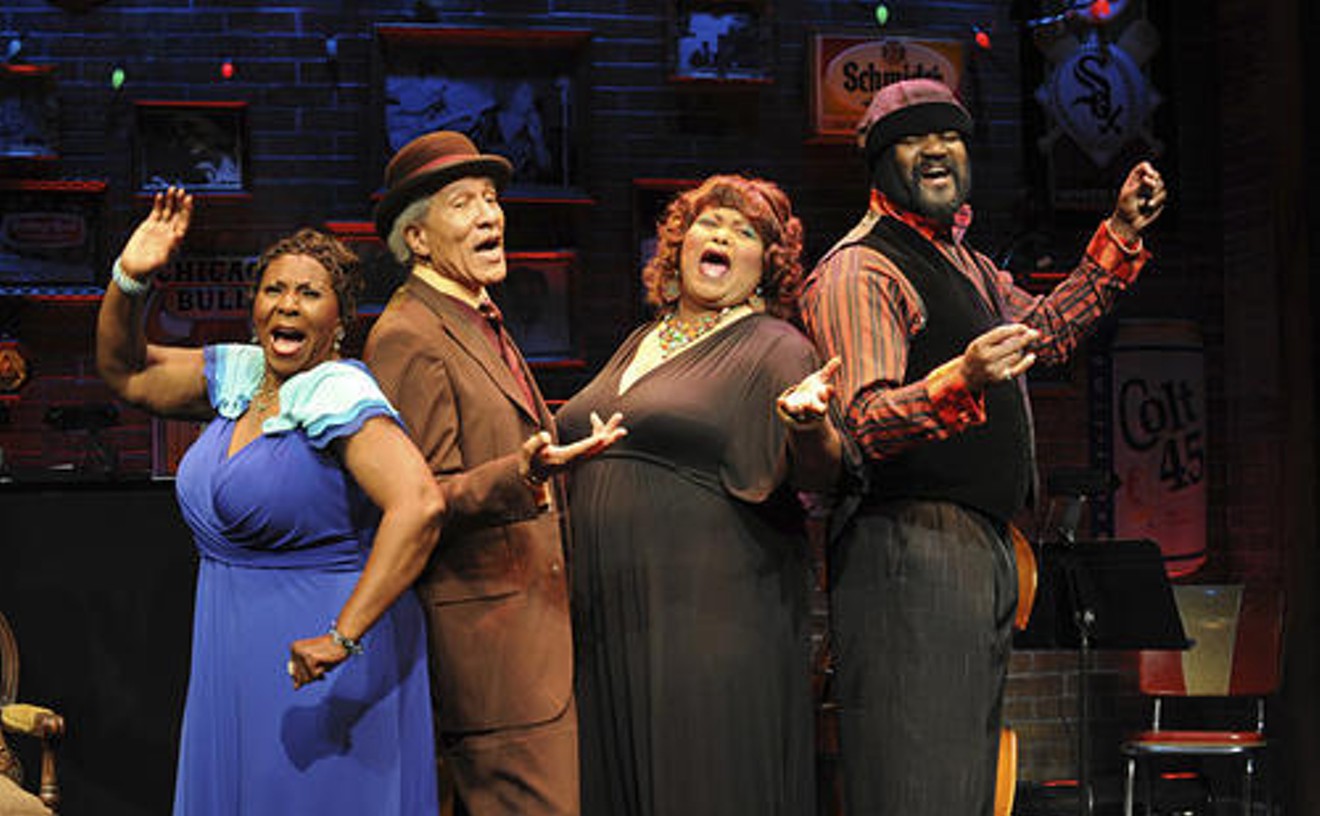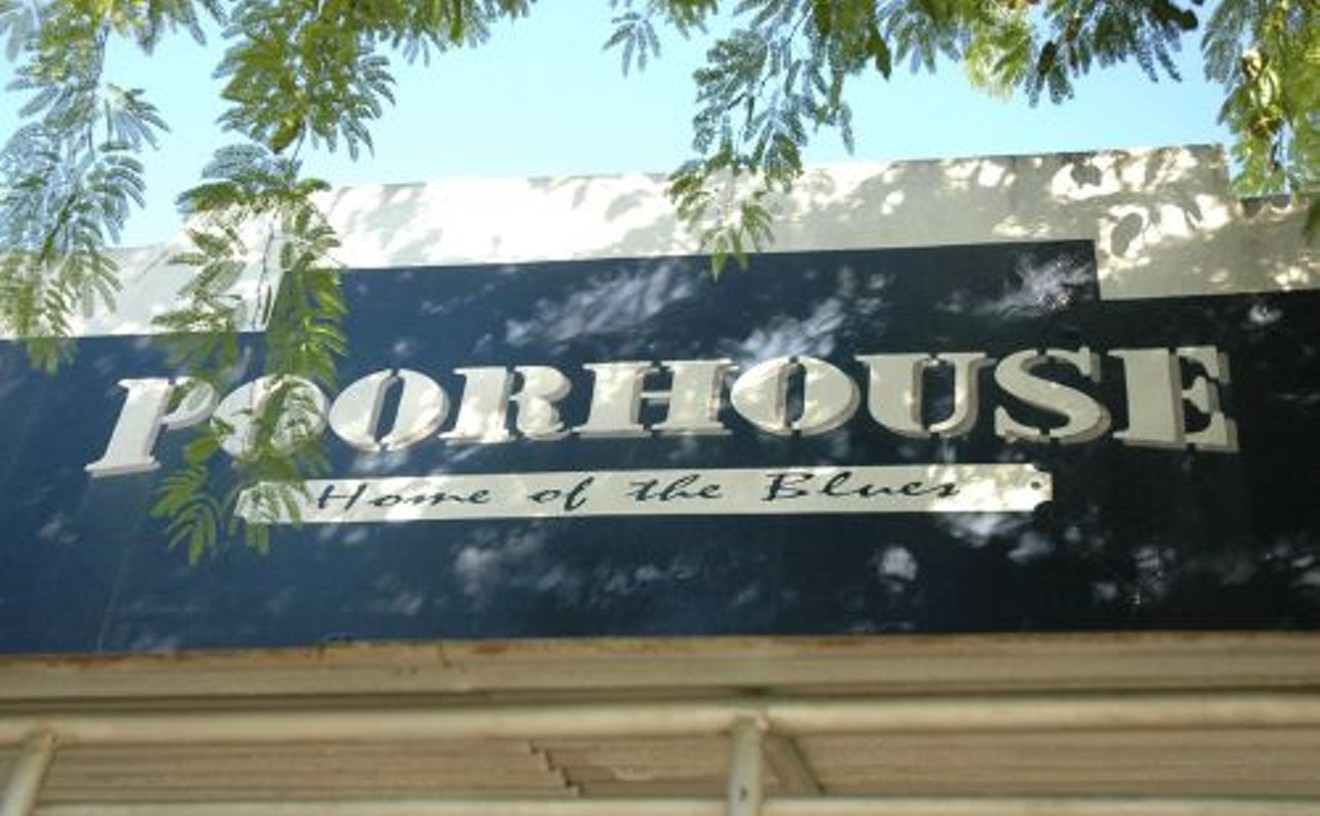Best Solo Show
The Devil's Music: The Life and Blues of Bessie Smith
Very early on in The Devil's Music, Miche Braden belted out a low blues note to let audiences know she is not just an actress; she's also a phenomenal singer. But Braden's acting was the real prize. The range of her characterization was sassy, wise, bitter, and flirtatious. She was inexhaustible, singing 13 gut-wrenching tunes in 90 minutes with no intermission or scene change. Her stamina and heartbreaking blues lent numerous dimensions to the character of Bessie Smith, giving her the stage presence of a diva and the theatricality of a broken woman. Although finding a talented actress who also happens to have a voice like Smith's is rare, Braden's exceptional performance proves it is possible.
Best Sports Bar
Palm Beach Ale House
The owners of this sprawling affair, which is convenient to both I-95 and the yuppie communities along Village Boulevard, say it is among Florida's largest sports bars, with more than a hundred TVs. Only two of them are big-screens, but that's of a piece with the intimate atmosphere. There are 5 a.m. sports bars -- slightly seedy, aprowl with lonely singles and anonymous mobs -- then there is the Ale House: a gathering of down-to-earth couples and groups who welcome strangers in a laid-back atmosphere clean-cut enough to draw a scattering of families. Most folks cheer for the local heroes -- any Florida team will do -- but the Washington Redskins fan club makes this place its home during the winter months, too. The décor's memorabilia includes a collection of vintage '60s sports-hero "nodders," little plastic dashboard dolls whose heads bob up and down. The usual Florida bar food menu features wings, burgers, ribs, and seafood crisply presented, and the grilled dolphin sandwich is a winner.
Best Spot for Skinny Dipping
Harbor Beach
There is a little neighborhood in Fort Lauderdale called Harbor Beach, most of which is south of the 17th Street Causeway. It is a place of retired folks in nice little houses; until you reach the beach, where little houses are replaced by massive condominiums. Beyond this wall of high-rises is a small private beach, the existence of which is known by just a few select people. Even during the day, the sandy beach is only sparsely populated, and at night no one is there at all, except for the occasional condo owner walking the sand... or rolling in it with a significant other or some version thereof. This brings us to our point. Deserted beaches are primo stomping grounds for getting naked and going swimming. The gates to this beach close at dark, but not to worry: Access is still easily gained through condo parking lots. Of course if you are caught and escorted from the premises because of your nudity, New Times will deny any knowledge of ever publishing this....
Best Stage Design
Rich Simone
This past season, every time a set caught the eye as aesthetically pleasing or clever, it was inevitably one of Rich Simone's creations. Simone's sets always seem to help bridge the gap between the audience and the actors, using the stage not only as a meeting point but also as a point of departure. Most recently his specialty seemed to be setting the mood for licentiousness, adultery, and other forms of sexual high jinks, as he did in Things We Do for Love and The Real Thing. In Things We Do for Love Simone created a three-story home perfect for the bawdy upstairs-downstairs humor that British playwright Alan Ayckbourn had in mind when he wrote this farce about a nymphomaniac, a soon-to-be spinster, a drunkard, and a vegetarian. Tom Stoppard's The Real Thing had a more sophisticated design (clean lines and streamlined contemporary furnishings) for this more erudite group of lovers (also British, come to think of it). Simone cleverly made use of upstage space to depict the playwright's play within a play. You could say he has a Thing for stage design.
Best Strip Joint
Booby Trap

So let's say Goldilocks has come to South Florida to find the strip joint that is juuuuust right. And say, for this issue of New Times, that little Goldy is a hetero guy. She looks for a club that's neither sleazy nor overly pretentious, a place where ham-fisted security goons aren't watching your every move. Our fairy-tale voyeur would feel quite comfy at Booby Trap, where the atmosphere is more discotheque than roadhouse. Variety is the name of the game at Booby Trap; dancers have been pulled from the ranks of amateurs, local pros, and porn stars. On a recent Wednesday night, a steady stream of entertainers showed up for work at the club sporting ponytails and workout suits, transformed themselves backstage, then wriggled and disrobed through several songs. After completing their sets, they mingled and chatted with patrons. A statuesque brunette was offered a lengthy neck-and-shoulder rub by one happy customer. Adult film star Harmony Grant jiggled her stuff during three sets. Frugal oglers will be happy to know that the cover charge is a mere $5 and the only pressure to keep buying drinks is the pounding of your heart.
- 2840 Hammondville Rd., Pompano Beach, 33069 Map
- 954-973-6888
- www.myboobytrap.com
Best Supporting Actor
Ray Lockhart
This year Ray Lockhart proved that you can trick the devil, but you can't fool an audience. As Lem, the man who murdered musician Robert Johnson, Lockhart was not only pivotal to the play's denouement but also essential to the emotional chemistry on-stage. Portraying a long-absent and embittered husband, Lockhart filled M Ensemble's tiny set with the emotional intensity and stage presence of a man who has spent the past few years splitting rocks and returns to find his wife bedding down with a handsome, mysterious stranger. Lockhart's raw physicality and confident stage presence elevated the quality of this drama immensely without overshadowing the rest of the cast. Finding the balance between rage and passion, his quarry worker turned out to be the gem in this bitter tragedy.
Best Supporting Actress
Tanya Bravo
To succeed in a supporting role, an actress must know her part within the context of the play as well as she knows the character she plays, and Tanya Bravo is one local actress who accomplishes this feat so consistently that her presence on the cast list always ensures an enigmatic evening of drama. She possesses the intensity and stage presence of an actress who always inhabits her character -- be it a punked-out band groupie in Caldwell Theatre's As Bees in Honey Drown, the young-girl version of Ruth in New Theatre's The Book of Ruth, or more recently as Chrysothemis in New Theatre's Electra. As the practical but ultimately vulnerable sister of Electra, Bravo showed her ability to channel conflicting emotions in relatively limited speaking parts. Her control and sharp instinct guarantee that her performance is never diminished by the size of the role she plays.
Best Theater for Plays
Florida Stage

Besides delivering first-rate performances, Florida Stage artistic director Louis Tyrrell this season struck the right chord with music lovers and theatergoers alike. His productions of Syncopation, The Music Lesson, and The Devil's Music: The Life and Blues of Bessie Smith proved theater can sing, dance, wail, and waltz. Syncopation, the story of two immigrants in 1911, underscored the basic human need to dance and hear music. As the characters awkwardly stumbled through the waltz and fox trot, they became more human. The Music Lesson transformed classical music classes into moving instruction on life and loss. The Devil's Music was a closely woven tapestry of the blues great Smith's music and harrowing life. Actress Miche Braden gave the role the electrifying singing voice and powerful stage presence it warrants. All three shows enlivened good theater with impressive, live, musical accompaniment. In each piece melody became an integral part of the cast as well as a vibrant and multifaceted vehicle for the excellent drama Florida Stage continues to produce.
- 262 S. Ocean Blvd., Lake Worth, 33462 Map
- 561-585-3433
- www.floridastage.org
Best Venue for Live Music
The Poor House

The bare-wood, dimly lit, rustic interior of the Poor House is a stark contrast to the majority of nightlife locales around downtown Fort Lauderdale's Himmarshee Village. Likewise, denizens of the Poor House are likely to be locals hoping to groove to live, original music (from the likes of Hashbrown, Plutonium Pie, Mr. Entertainment, or the Hep Cat Boo Daddies) rather than the canned dance fare booming from its neighbors. Here you'll rub up against a velvet Elvis, not velvet ropes. The suds selection is also top-drawer. During the steamy summer months, quaff a tall Tucher studded with a lemon slice. When it's cool outside grab an Amber Bock or a nutty Newcastle. The barkeeps are amateur comedians, which adds to the fun. The music's loud enough that you can hear every note, indoors or out. And you can get close enough to the performers to see the whites (or at least reds) of their eyes. If you're put off by the chi-chi crowds prowling the downtown streets on weekends, dip into the Poor House -- it feels normal in here. And is that so wrong?
- 110 SW Third Ave., Fort Lauderdale, 33312 Map
- 954-522-5145
- www.poorhousebar.com
Best Venue for National Acts
Broward Center for the Performing Arts

Keith Douglas
If you live in or around the "Venice of America" that is Fort Lauderdale and don't have a boat -- or even that much more economical option, a friend with a boat -- try attending an event at the Broward Center for the Performing Arts. Architect Benjamin Thompson designed the Au-Rene Theater to replicate the experience of being on an ocean liner. He perched it on a hill overlooking the New River and pointing toward the Atlantic, curved the structure and filled in the front with a stories-high wall of glass to resemble the prow of a ship, and finished the theater's ceilings and balustrades in lapstrake cypress. The blue-and-green waves in the carpeting underfoot add to the sensation of being on the bounding main. Oh, did we mention that the acoustics are perfect? Or that there's not a compromised sightline in the auditorium? Or that the venue offers the crème de la crème of national acts from the symphony to the Broadway musical to the Grammy Award winner? No? Silly us.
- 201 SW Fifth Ave., Fort Lauderdale, 33312 Map
- 954-462-0222
- browardcenter.org





